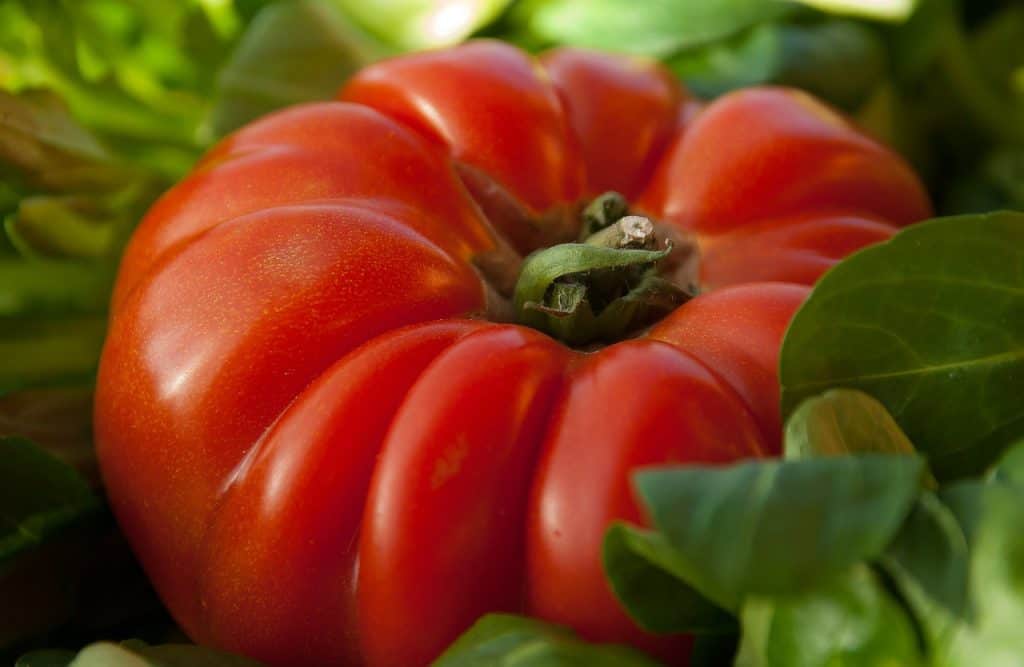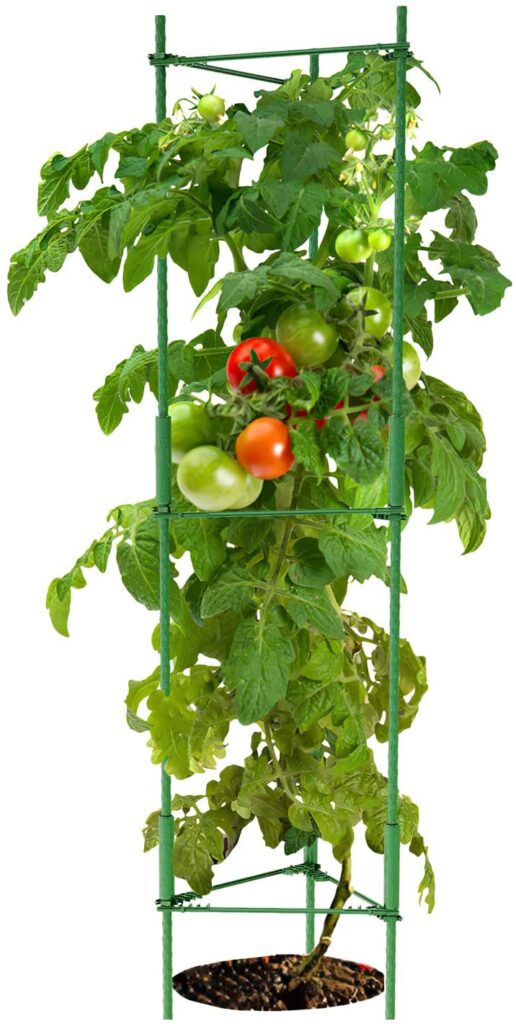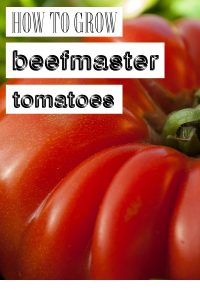Beefmaster Tomato
Beefmaster tomato plant care
The Beefmaster hybrid tomato plant has undergone some improvement in fairly recent times. It produces huge, red-colored beefsteak fruits which are relatively tolerant to cracking.
The tomato is perfect for slicing and, because of this, perfect for sandwiches, too.
Is the Beefmaster hybrid tomato good for canning?
I’ve not personally tried to can Beefmaster tomatoes. But from reading through what others say, yes, Beefmaster tomatoes are really good for canning.
Beefmaster tomato taste?
The flavor, while being sweet, is also quite mild.
Beefmaster tomato plant height? How tall do Beefmaster tomatoes grow? (the tomato plants as opposed to the fruit 😉 )
At maturity, Beefmaster tomato plants grow to between eight and ten feet in height.
You’ll want to tie your Beefmaster tomato plants to stakes or grow them in tall cages because they do need support given they grow pretty tall.
K-Brands tomato cages are a good option for tomato plant staking/caging. Support is up to 72 inches so these tomato supports are plenty high enough for taller, indeterminate tomato plants like Beefmaster.
And don’t forget your tomato plant tie-ins. The Velcro adjustable plant ties are reusable, gentle on the plant stem, and a great price.
Velcro Adjustable Gentle Tomato Plant Ties
Beefmaster tomatoes are resistant to fusarium wilt, to verticillium wilt, and also to nematodes.
When to pick Beefmaster tomatoes?
Beefmaster tomato size
The fruit reaches heavyweight proportions of between 18 to 32 oz, depending on the variety, and reaches maturity around 80 days after transplanting. In other words, your Beefmaster tomatoes (the fruit) will be ready for harvesting around 80 days or so after transplanting the plants into the garden to their final growing area.
Space your plants at 20-36 inches (dependent, again, on variety).
Is Beefmaster tomato determinate or indeterminate?
As mentioned, Beefmaster is an indeterminate tomato variety. It is also a hybrid which means you, unfortunately, cannot save seed for the following season. If you try, the seed will not come true to type.
What does this mean? The fruit in successive years will likely be different from those you harvested from your first plant.
What you need to know about how to grow Beefmaster tomato plants – planting Beefmaster tomatoes
The plant requires full sun to achieve a full, healthy crop.
Plant your Beefmaster hybrid tomatoes 20 to 36 inches apart – planting distance depends on which type of Beefmaster tomato variety you have.
Plant your tomato plants deeply into the soil. You can bury as much as 2/3 of the stem. This encourages further root growth – always a good thing!
For best results, you’ll want to have a soil that is nutrient-rich and well-drained. You can amend your soil using organic matter/ compost before planting. Try to get your soil to a pH of between 6.4 and 6.8 (slightly acidic).
How do you know if your soil is acidic, more on the alkaline side, or if it’s of a neutral pH?
Well, you could send a soil sample to an agricultural testing service. It’s pretty cheap – typically around $8 or so (if you live in the US).
Either that or you can test it yourself.
If you did chemistry at school a long ways back (yes, I’m showing my age here) you’ll have likely used litmus paper to test pH. Fortunately, these days litmus paper is not a requirement. Instead, use a soil pH meter.
One of the best currently available, if not the best currently available pH soil meters is the PentaBeauty Soil Test Kit. It’s a three-in-one job: it measures pH, moisture, and light levels.
PentaBeauty Soil Test Kit for Testing Soil pH, Soil Moisture, and Ambient Light Levels
How do you achieve this soil acidity if you find your soil to be more on the alkaline side?
You can amend your soil using something like Jobe’s Organic Soil Acidifier:
Otherwise, it’s a matter of adding peat moss which has a very low pH (very acidic) as a soil conditioner. Best to try to get peat moss that has come from a renewable source.
Simply add some peat moss around the base of each of your tomato plants.
Another way to increase soil acidity is to apply acidifying fertilizers. Fertilizers that contain ammonium sulfate, ammonium nitrate, or sulfur-coated urea are ideal.
Keep in mind that ammonium sulfate is a potent chemical blend. If not used with care it can burn your tomato plants. Before making applications, be sure to read the guidelines carefully.
Miracle-Gro Plant Food for Azaleas, Camellias, and Rhododendrons is a good choice of acidifying fertilizer for tomatoes. But any fertilizer that is suited to azaleas, rhododendrons, camellias, magnolias, will be suitable for tomatoes.
Miracle-Gro Plant Food for Azaleas, Camellias, and Rhododendrons
If your Beefmaster tomatoes are in containers, and you wish to increase acidity level of the medium it’s pretty easy to do. Add a couple of tablespoons of vinegar to 1 gallon of water when you’re watering your tomatoes.
Why not just use vinegar if your tomatoes are planted in the garden?
The vinegar leaches out of the soil too quickly for your plants to gain benefit.

Throughout the growing season, aim to keep the soil persistently moist. The soil must remain moist to avoid your fruit from suffering blossom end rot and cracking. You can add mulch to the soil surface to reduce the amount of water evaporation.
Any problems to watch for?
Keep a lookout for pests such as slugs, hornworms, rodents (yes, mice love tomatoes, too), and pill bugs.
Read: 7 Beneficial Insects for Tomato Plants
Disease resistance
Watch for early and late blight fungal disease – both of which are encouraged by humid weather.
Fortunately, because of the recent improvements to this F1 hybrid tomato, Beefmaster has few if any real problems.
Beefmaster fruits, when ripe, are deep red in color while still maintaining a high level of firmness. It’s wise to find out about your specific variety of Beefmaster to be sure when to harvest your crop.
Do not refrigerate your Beefmaster tomatoes after harvesting. Instead, store at room temperature in a shady place.
Keep the stems and caps on the tomatoes as this allows them to store better and for longer.
Consume, or use your tomatoes within a week of harvesting. Of course, this is dependent on the ripeness of the fruit when it was harvested. Hence, it’s a general rule.







My fruit on beef master tomatoes are small and have large rotten spots on bottom of tomatoes. What is the problem?
Hi Betty, thanks for your question.
Unfortunately, it sounds as if your tomato plants have developed blossom-end rot. Blossom-end rot (BER) is caused by low calcium concentration in the fruit.
How does BER occur?
Could be caused by a number of reasons, really.
Typically, BER occurs when there are big moisture fluctuations around the roots. This reduces the uptake of calcium. And when there’s not enough supply of calcium and there’s a rising demand (when the fruit is growing in size and number) the fruit’s tissues begin to break down.
A deficiency of calcium can also be caused because of the addition of too much fertilizer that’s high in nitrogen. Can also be due to soil salt levels being high. Or because of damage to your tomato plant roots at some stage throughout their cultivation.
Mind you, Betty, it’s perfectly normal to have some BER on your early tomatoes. That’s because at this stage the plants undergo some stress while the initial fruit is setting.
If the damage is small, you can, if you wish, just trim it off the fruit and consume as you normally would.
Hope this is helpful, Betty. Good luck!
Hi,
Most of the flowers on my tomato beef master are not setting fruit, just a few of them. No clue why. I try to keep the plant monitored with regular irrigation and fertilisers that contains (NPK). They have good foliage and growing aspect. Any advise?
Many thanks
Hi Ashraf, what you’re experiencing with your Beefmaster tomatoes is a relatively common problem for tomato plant growers in general. Not that this will be of much consolation to you, I’m sure. Here are a few things to be aware of in order to hopefully combat the problem with some success.
Temperature:
If the nights are cool (consistently below 55F) or there are regular days that are above 90F and nighttime temps are above 75F tomato plants are merely intent on survival so they forgo fruit production. Optimal daytime temps range between 70F and 85F, at least in terms of setting fruit.
Pollination:
If there’s little to no insect pollination going on then you can mimic the pollination process by gently shaking your plants so that the pollen spreads. Or you can try the same method/s shown in this video:
https://youtu.be/Y4_Mi-EwFqw
Watering:
You’ve noted that you water frequently. Make sure you avoid watering every day. Just water a couple of times on a weekly basis and water deeply enough so the root systems are getting plenty of moisture.
Fertilization:
You’re also feeding regularly. All good again. Just make sure that your tomato feed is low in nitrogen (N) since nitrogen encourages foliage growth and that can be at the expense of fruit production. High potassium (K) is ideal for fruit production.
Too much blossom:
If there are too many blossoms it can reduce the amount of fruit production (yes, seems counterintuitive). It is, when too many blossoms, a matter of survival of the fittest. In which case, you could try pinching off some of the blossoms if there are too many. Again, this will encourage more nutrients to be invested in fruit production.
Hopefully, something on this list works for you. Wishing you the best, Ashraf. Do let me know how it goes, thanks!
Regards,
Joseph